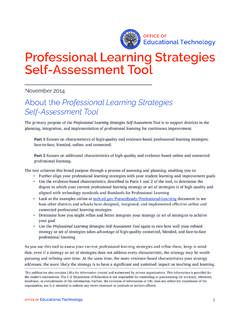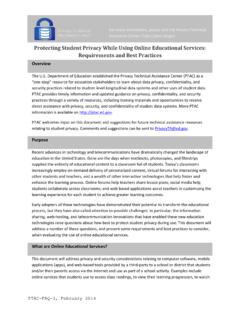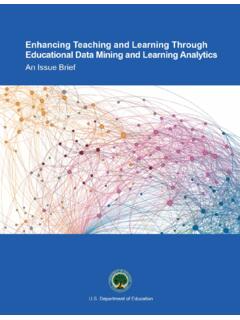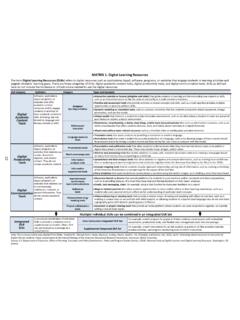Transcription of Characteristics of Future Ready Leadership
1 ICharacteristics of Future Ready LeadershipA Research DEPARTMENT OF 1 Collaborative Leadership 3 Personalized Student Learning 5 Robust Infrastructure 7 Personalized Professional Learning 8 Development Process 10 References 121 IntroductionStrong Leadership is essential to systemic, sustainable change in education. Superintendents and their Leadership teams, with the support of state and local leaders, are key to leading the transition to digital learning in their districts. The challenges of doing so are multifaceted, and range from unifying a diverse set of stakeholders who may hold divergent views on the best path forward, to updating physical and technical infrastructure, to designing new learning models and resources, to building capacity of educators to take on new roles and new approaches to classroom instruction.
2 Superintendents throughout the country have expressed the desire for evidence-based approaches they can rely upon to lead this change. In response to this need, the Department of Education s Office of Educational Technology, in partnership with the American Institutes for Research (AIR), developed a research-based synthesis defining a set of policies and practices implemented by successful Future Ready district leaders. The resulting rubric provides a basis for personalized professional learning to expand the capacity of district superintendents to effectively transition to digital rubric served as the foundation for developing a personalizable playlist of videos for superintendents highlighting essential policies and practices for successfully leading the transition to Future Ready schools.
3 Fifty videos were shot on-site at eight school districts across the country. Collectively, these videos constitute a virtual site visit hosted by some of the most forward leaning Future Ready district leaders in the country sharing lessons learned and effective practices with their peers. In addition, the videos were carefully curated to represent each of the 27 evidence-based policies and practices described below. Although the rubric was originally designed to support the development of the Future Ready professional learning videos, the rubric may also prove useful for strategic planning for superintendents, their Leadership teams, and those supporting them in other contexts. The rubric is aligned with the recommendations of the 2016 National Education Technology Plan, ensuring that as district leaders work to become Future Ready they will also be making progress toward implementing the broader technology vision for the Future Ready Leaders rubric defines exemplary dimensions of policy and/or practice within four focus areas (see Table 1).
4 The rubric also specifies the types of evidence that support the description of exemplary policy and practice. 2 Table 1. The Four Focus Areas of the Future Ready Leaders RubricFocus AreasDescriptionCollaborative LeadershipCommitment to demonstrating strong Leadership aptitude, developing the vision, securing the ongoing funding, building a district-wide Leadership team, and garnering broad-based support to ensure a successful digital learning transition for students and teachersPersonalized Student LearningPersonalized pathways for student learning through active and collaborative learning activities, which are aligned with standards, chosen through ongoing assessment of students progress and preferences, and supported by the use and creation of rich content and robust toolsRobust Infrastructure Equitable access to bandwidth, wireless networks, hardware, and devices.
5 Managed by support personnel for reliable use both inside and outside of schoolPersonalized Professional Learning Ongoing, job-embedded, and relevant professional learning designed and led by teachers with support from other experts to assist other teachers, administrators, and support personnel in making the digital transitionTypes of Supporting Evidence Experimental research (ER) empirical research that uses an experimental or quasi-experimental approach to test a theory of action and explore connections between inputs ( , programs, practices, policies) and outcomes Descriptive research (DR) studies that use observations, surveys, case studies, or interviews to describe a phenomenon, intervention, or program Grey literature (GL) multiple resources, such as white papers and technical reports, from reputable sources that provide helpful information to the field Professional standards (PS) standards (sometimes explicated by aligned self-assessments) developed by leading organizations in the field and widely accepted as reflecting consensus about best practices Expert opinion (EO)
6 Conclusions or conjecture collected from interviews or other resources from experts in the field with recognized practical or research-based expertise3 Collaborative LeadershipCommitment to demonstrating strong Leadership aptitude, developing the vision, securing the ongoing funding, building the district-wide Leadership team, and garnering the broad-based support needed to ensure a successful digital learning transition for students and teachersDimensionTypes of Supporting EvidenceExemplaryStrong Leadership AptitudeDR, GL, PS, EODistrict Leadership demonstrates situational awareness, seeks input in decision making, stimulates intellectual inquiry and innovation, and serves as a change agent for district-wide Vision for Teaching, Leading, and LearningDR, GL, PS, EODistrict Leadership convenes a team of diverse stakeholders (such as school board members, district staff, teachers, parents, community members, and students) to collaborate in adopting and communicating clear goals for Future Ready teaching, leading, and learning in the district.
7 Technology facilitates does not define these of Trust and InnovationDR, GL, PS, EODistrict Leadership encourages leaders at all levels to foster a culture of risk taking, experimenting, and sharing innovative ideas. The district develops a system for gathering and responding to input on centralized decisions that benefit from scale ( , purchasing devices) while also trusting schools to make localized decisions to meet the needs of their communities and the goals of the shared CommunicationsGL, PS, EODistrict Leadership uses appropriate media and technology tools to reach a wide audience of stakeholders to establish an ongoing communications system and feedback loop. From the inception of the vision to its implementation, district Leadership explains the vision, creates a process for gathering input, builds community support, interacts with stakeholders, and communicates successes and Plan for ImprovementDR, GL, PSA strategic plan for accomplishing the shared vision is collaboratively developed by district Leadership to provide specific action steps, which are aligned with a theory of change.
8 An articulated plan for collecting formative and summative evaluation data at multiple points throughout the school year also is created, with clear criteria for decision making. Modeling of Technology UseDR, GL, PSDistrict leaders, including the superintendent, effectively model the use of technology and their commitment to personalized learning and development through active participation in and support of technology-related professional learning of Supporting EvidenceExemplaryDistrict PoliciesDR, GL, PS, EODistrict Leadership ensures that district policies support the shared vision for Future Ready teaching, leading, and learning ( , acceptable use, account creation and termination, administrative access, document retention, e-mail and mass communications, encryption, identity management, and passwords).
9 Student safety and privacy are protected while allowing students and teachers to explore online environments and digital tools without unwarranted FundingDR, GL, PS, EODistrict Leadership develops funding plans to cover start-up and ongoing maintenance and upgrade costs during a 5- to 10-year period. The district uses multiple strategies to commit new resources specifically for digital learning as well as leverages existing funds by pooling budgets across departments ( , curriculum and instruction, professional development, facilities), seeking partnerships across districts or organizations to maximize purchasing power, or securing grants or other outside Student LearningPersonalized pathways for student learning through active and collaborative learning activities, which are aligned with standards, chosen through ongoing assessment of students progress and preferences, and supported by the use and creation of rich content and robust toolsDimensionTypes of Supporting EvidenceExemplaryRigorous and Relevant Learning OutcomesDR, GL, PS, EODistrict Leadership ensures a clearly defined set of district- and school-wide learning outcomes to guide instruction.
10 Outcomes are defined in terms of competencies and align with the district s vision for Future Ready teaching and learning and state standards. The learning outcomes reflect the multidisciplinary nature of knowledge; prepare students for our participatory culture through attention to digital literacy and citizenship; and attend to general skills and dispositions, such as reflection, critical thinking, persistence, and Assessment DR, GL, PSDistrict Leadership puts policies into place that ensure that the district provides educators with the tools, professional development, and ongoing support to collect and analyze evidence of student learning on an ongoing basis. Evidence is diverse, including student and teacher observations and reflections, student work, formative and summative assessment results, and data from analytics embedded within learning activities and software.


















